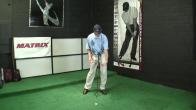My Favorite Videos
How to Find Success on the Greens with the Perfect Putting Stance
Learn the 3 Tour Pro Consistency Secrets You've NEVER Heard!
Watch part 2 now to see how you're moving your body in the opposite direction of the pros!
Published: March 29, 2022
How to Find Success on the Greens with the Perfect Putting Stance
“Drive for show but putt for dough” is one of the oldest sayings in golf - and with good reason.
Tour pros know only too well that it’s largely on the greens that tournaments are won and lost and prize money checks earned.
And in the elusive quest for an infallible way of getting the ball into the cup they’ve come up with innumerable different styles, strokes, training devices and clubs.
[https://www.youtube.com/watch?v=qrhPDxHB1hs]
But the one common factor that all good putters share is a sound putting stance.
To Find Out How Your Putting Set-Up Can Slash Stokes from Your Game Click Here Now
Putting – The Game Within a Game that Anyone Can Master
And the great thing about putting – which in terms of strokes is half the game - is that success is relatively easy to achieve.
Even with the help of modern equipment there are few golfers, if truth be told, who have the strength, flexibility, and coordination required consistently to hit a drive of 250 yards or more.
Many also struggle with the precise demands of the long and medium irons.
But almost anyone who is prepared to practise a few fundamentals can become a good putter.
The Key Elements of Open Stance Putting
There are many things in putting that you can experiment with, but there are really only three essential elements of a sound set-up –
-
the position of the body and feet;
look to stand as upright and naturally as possible without crouching or leaning in either direction. For stability, feet should be slightly wider than a neutral stance with weight evenly distributed between left and right.
-
the position of the eyes and head;
to ensure the correct alignment of the putter face with your chosen target line your head and particularly your eyes should be vertically above the target line. A simple, stationary turn of the head will then enable you to track the path of the ball after impact, with no temptation to lift or dip.
-
the position of the ball
Some teachers advocate placing the ball forward in the golf putting stance to allow it to be struck an ascending blow. The theory is that this imparts overspin to the ball which helps keep it on a true path. There may be some truth in this. But it is a risky technique, particularly when putting under pressure, and the vast majority of players will achieve a more consistent strike by positioning the ball in the center of their stance - the natural low point of the stroke arc.
The Single Most Important Principle of Golf Putting
Finally, if there is a single overriding fundamental it’s that you should stand as naturally and comfortably as possible.
Any attempt to force yourself into an unnatural position will likely lead to involuntary movements of the head and muscular tension throughout the body, arms, and hands.
Either of these will render impossible the smooth, relaxed stroke that is essential for accuracy.
And on that point, it’s important to make sure that you grip the club as lightly as possible, with only just enough pressure to keep the clubface square through impact.
Now Click Here To Hole More Crucial 6-Footers With an Open Putting Stance
FAQs
Where should I put my ball in the putting stance?
Ensure you have the ball directly center in your stance so you can strike the putt at the bottom of the putting arc.
Where should your feet be when putting?
Your feet should be aligned parallel to your putting line like railroad tracks for consistency.
What is the best grip for putting?
The best putting grip is the one that ensures your hands do not tense up and release the putt down your target line.
Proper putting fundamentals start with the stance. You want a stance that's wide enough for stability, but narrow enough to be comfortable.
 The hip sockets are about at your front belt loops
The hip sockets are about at your front belt loopsWe recommend a stance that's about two inches wider than your neutral joint alignment. What does that mean?
Neutral joint alignment is your body's anatomically correct position. Your body is designed to stand naturally in this position.
Your hip sockets are located right around the first belt loop on your pants, or slightly lower. When you are in neutral joint alignment, each joint is stacked directly on top of the one below, meaning that your knees and ankles are directly under your hip sockets.
Hang a club down to see what this looks like, as in the first photo in the series below.
When we say two inches outside of neutral, we mean that you should widen your stance by moving each foot two inches beyond the neutral point. The second photo below shows what that looks like.
Two inches outside of neutral gives you enough stability to stand nice and firm over the putt, but it's also narrow enough that you feel comfortable.
If you get too narrow, with your feet just a few inches apart, it may be difficult to stay balanced if the wind starts to blow or you're on a hill. If your golf stance gets too wide, it's just not going to feel natural or comfortable.
 Stances: Neutral, two inches outside of neutral, too narrow, too wide
Stances: Neutral, two inches outside of neutral, too narrow, too wideBall Position
The next aspect of setting up a putt is ball position.
The ball actually sets down in the grass a little bit. The weight of it presses the grass down and it nestles in. You want the natural loft of the putter to lift the ball up just enough that it can roll on top of the grass.
Most putters have about 4-5° of loft that we can use to get the ball up on top of the grass and rolling right away.
 The putter arc delofts going back, has a low point, gains loft going through
The putter arc delofts going back, has a low point, gains loft going throughJust like any other golf swing, the putting stroke follows an arc. As the putter swings back and through, it obviously has a low point.
The low point of the arc is where the putter has the correct amount of loft. Like any club, it delofts on the way back, and gains loft as it swings forward.
You want to make contact with the ball at the bottom of that swing arc. In order to do that you need to put the back of the ball in the middle of your stance.
 Put the back of the ball in the middle of your stance
Put the back of the ball in the middle of your stanceDraw an imaginary line through the middle of your stance and position the back of the ball on that line.
There are several reasons for this:
If it's too far back, you'll end up hitting down on the ball. You'll come in with a descending blow that will smash the ball down into the grass, and then it will hop up and bounce.
If it's too far forward, you'll catch it on an ascending blow. That will loft the ball into the air and, again, it will start to bounce.
When you place the ball in the center of your stance you can contact it at the very bottom of the swing arc and use the natural loft of the putter. The ball will get a great roll right away.
Weight Distribution
Weight distribution for putting is very simple. We recommend that you just keep your weight centered 50/50 between your feet and maintain that throughout the entire stroke.
 When the ball is too far forward it is struck on an ascending blow
When the ball is too far forward it is struck on an ascending blowThat way the bottom of the swing arc is in the middle of the stance. If you tend to lean to one direction or the other, that will change your swing arc.
Take your normal address position and balance your weight evenly. When you swing the putter you'll find that the arc of your swing grounds out right in the middle.
As you start to shift to the right, the bottom of the stroke moves a little farther back. If you shift left, the reverse is true.
Just keep a nice 50/50 weight distribution between your feet throughout the putting stroke. Keep that even balance as you swing back and through for ultimate consistency.
Checkpoints for Practice
- The three putting setup fundamentals are stance width, ball position, and weight distribution
- Stance Width: Stand with each hip, knee, & ankle perfectly stacked, then move each foot 2" wider
- Ball Position: Place the back of the ball on the center line of your stance
- Weight Distribution: Balance your weight 50/50 between your feet and maintain that balance throughout the stroke
























































































































































































































































































































































































































